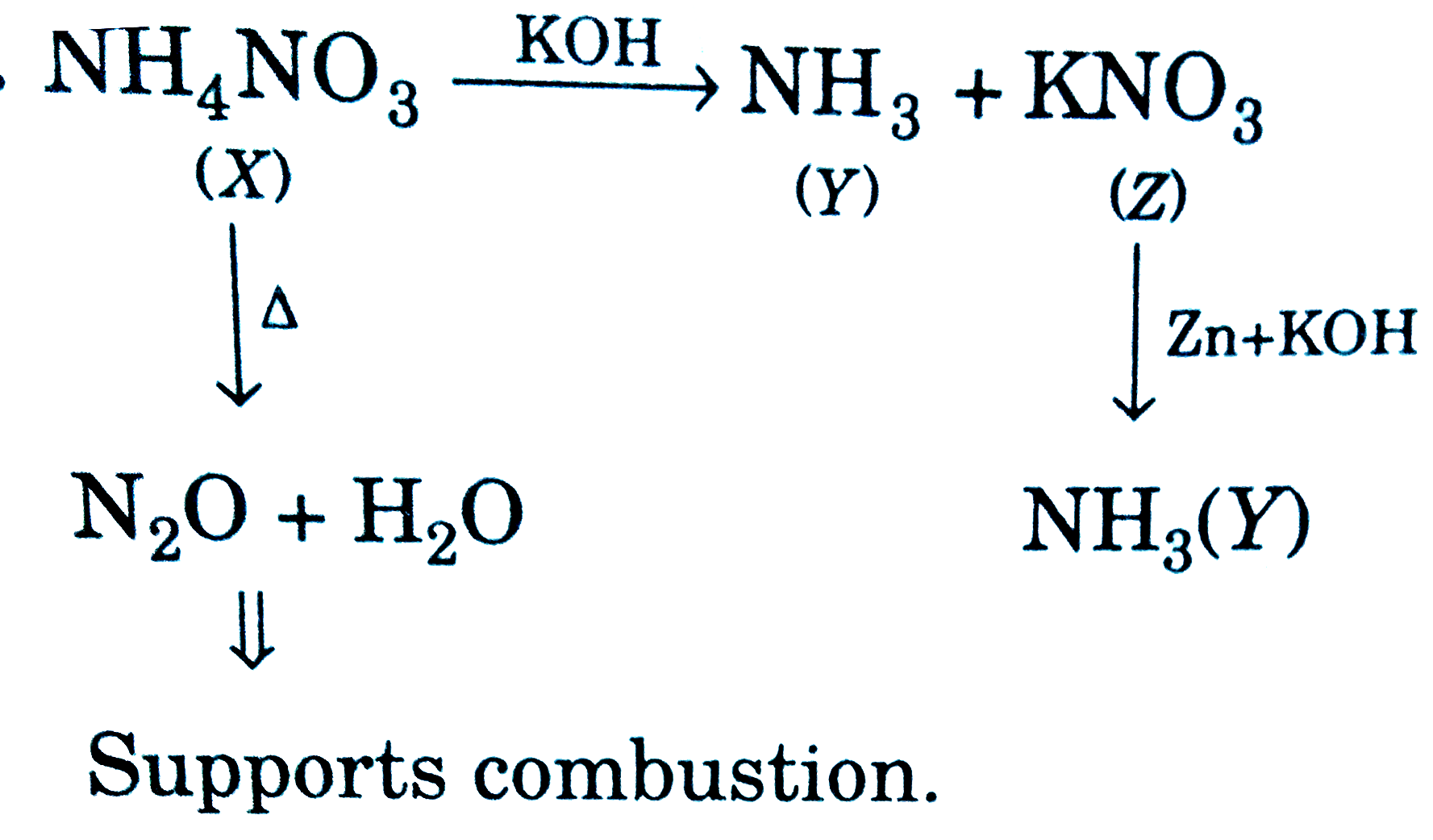(X)KOH−−→(Y) (gas turns red litmus blue)+(Z)Zn+KOH−−−−−−→(Y) (gas).
(X)Δ−−→ gas (does not support combustion) identify (X) to (Z):
X=NH4NO2Y=NH3Z=KNO2
X=(NH4)2Cr2O7Y=NH3Z=Cr2O3
X=(NH4)2SO4Y=NH3Z=K2SO4
X=NH4NO3Y=NH3Z=KNO3
The correct Answer is:D

Supports combustion.
Topper's Solved these Questions
- BOOK - GRB PUBLICATIONCHAPTER - SALT ANALYSISEXERCISE - G: Ist Group Cations20videos
SALT ANALYSIS
- BOOK - GRB PUBLICATIONCHAPTER - SALT ANALYSISEXERCISE - H: IInd Group Cations49videos
SALT ANALYSIS
- BOOK - GRB PUBLICATIONCHAPTER - SALT ANALYSISEXERCISE - E.Precipitation/Redox Reacttions48videos
SALT ANALYSIS
- BOOK - GRB PUBLICATIONCHAPTER - S BLOCK ELEMENTSEXERCISE - SUBJECTIVE TYPE9videos
S BLOCK ELEMENTS
- BOOK - GRB PUBLICATIONCHAPTER - THERMODYNAMICSEXERCISE - All Questions704videos
THERMODYNAMICS
Similar Questions
Knowledge Check
- Question 1 - Select One
(X)KOH−−→(Y) (gas turns red litmus blue)+(Z)Zn+KOH−−−−−−→(Y) (gas).
(X)Δ−−→ gas (does not support combustion) identify (X) to (Z):AX=NH4NO2 Y=NH3 Z=KNO2BX=(NH4)2Cr2O7 Y=NH3 Z=Cr2O3CX=(NH4)2SO4 Y=NH3 Z=K2SO4DX=NH4NO3 Y=NH3 Z=KNO3 - Question 2 - Select One
(T)imparts violet colour to flameCompound (U)+conc. H2SO4−−−−−−−−−−−−−−−−−→(V)Red gasNaOH+AgNO3−−−−−−−−−→(W)Red ppt.NH3 soln.−−−−−−→(X)
(W)dil. KCl−−−→(Y) white ppt
(U)NaoH−−−→Δ(Z) gas (gives white fumes with HCl)
Identify (T) to (Z).AT=KMnO4,U=HCl,V=Cl2,W=HgI2,X=Hg(NH2)NO3,Y=Hg2Cl2,Z=N2BT=K2Cr2O7,U=NH4Cl,V=CrO2Cl2,W=Ag2CrO4,X=[Ag(NH3)2]+,Y=AgCl,Z=NH3CT=K2CrO4,U=KCl,V=CrO2Cl2,W=HgI20,X=Na2CrO4,Y=BaCO3,Z=NH4ClDT=K2MnO4,U=NaCl,V=CrO3,W=AgNO2,X=(NH4)2CrO4,Y=CaCO3,Z=SO2 - Question 3 - Select One
(T) imparts orange colour compd(U)+conc.H2SO4−−−−−−−−−−−−−−−→ (V) Red gas NaOH+AgNO3−−−−−−−−−→ (W) Red ppt. NH3soln.−−−−−→ (X)
(W) Red ppt. dil.HCl−−−−→ (Y) white ppt.
(U) NaOH−−−→Δ (Z) gas (gives white fumes with HCl) sublimes on heating .
Identify (T) to (Z) .AT=KMnO4,U=HCl,V=Cl2,W=HgI2,X=Hg(NH2)NO3,Y=Hg2Cl2,Z=N2BT=K2Cr2O7,U=NH4Cl,V=CrO2Cl2,W=Ag2CrO4,X=[Ag(NH3)2]+,Y=AgCl,Z=NH3CT=K2CrO4,U=KCl,V=CrO2Cl2,W=HgI2,X=Na2CrO4,Y=BaCO3,Z=NH4ClDT=K2MnO4,U=NaCl,V=CrO3,W=AgNO2,X=(NH4)2CrO4,Y=CaCO3,Z=SO2
X+O2→Y,Y+H2O→Z,Z turns red litmus to blue then X may be
View Solution(T) imparts violet colour compd(U)+conc.H2SO4−−−−−−−−−−−−−−−→(V)Red gasNaOH+AgNO3−−−−−−−−−→(W) Red ppt.NH3soin.−−−−−→(X)
(W)Red ppt.dil.HCl−−−−→(Y) white ppt.
(U)NaOH−−−−−→Δ(Z) gas (gives white fumes with HCl)
The compound 'T'&'U' areView Solution(T)imparts violet colour to flameCompound (U)+conc. H2SO4−−−−−−−−−−−−−−−−−→(V)Red gasNaOH+AgNO3−−−−−−−−−→(W)Red ppt.NH3 soln.−−−−−−→(X)
(W)dil. KCl−−−→(Y) white ppt
(U)NaoH−−−→Δ(Z) gas (gives white fumes with HCl)
Identify (T) to (Z).View SolutionColourless salt (X)Δ−−→(Y)Cu2+,Δ−−−−−→ coloured head (Z) (X) can be
View SolutionSiCl4H2O−−→XHeat−−→YNaOH−−−→Z
find X,Y,Z.View Solution


